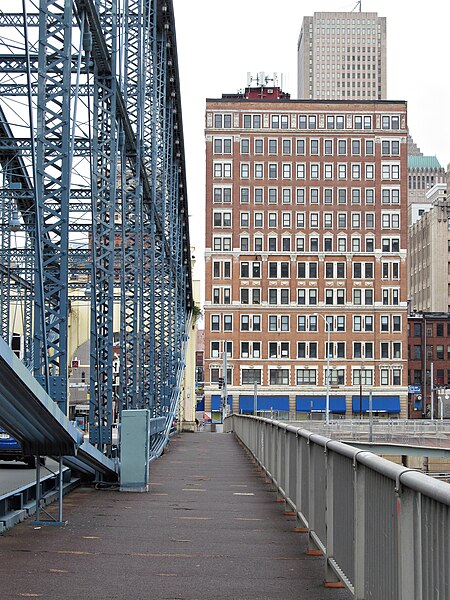
The House Building (1902, architect James T. Steen) looms before us as we cross the Smithfield Street Bridge.


An image from an advertisement in the National Vaudeville Artists’ Annual for 1928. You and your dancing poodles are invited to shop here. This building is now under renovation, and with the removal of some later accretions the shadows of the Frank & Seder signs are visible (see the recent photos here).

In the little corner of downtown Pittsburgh near First Avenue there are still some half-blocks that never entered the skyscraper age. Here we can see some of the humbler pre-skyscraper commercial architecture of Pittsburgh. The first floor of the front of this building has been heavily altered, probably by someone who wanted to make it look more Victorian and ended up making it look more 1978. But the rest of the building is a typical small Italianate structure of the 1870s.

Kaufmann’s was the Big Store, but Frank & Seder, facing Kaufmann’s across a whole block of Smithfield Street, was hardly small. The building is now under restoration.

The restoration has peeled away later accretions, and we can see the shadows of an old sign at the corner of Forbes Avenue.

Two layers of ghost signs still memorialize the old department store to pedestrians on Fifth Avenue.


Compare the photograph to this illustration of the store in 1927.

The first structural use of aluminum was this ornate tracery spire on the Smithfield Congregational Church by Henry Hornbostel. Unfortunately the decorative stamped concrete that covers the rest of the church is crumbling, and it will cost millions to repair. The church has been shrouded in mesh for years now, but the spire still proudly catches the early-morning sun.

This concrete spiral on the Smithfield Street side of the Smithfield-Liberty Garage is certainly a striking addition to the streetscape. Whether it is a good addition may be left to other critics. Father Pitt’s own opinion is that it would be welcome on a street of other modernist buildings, but it harmonizes poorly with its Victorian neighbors.
Old Pa Pitt sometimes wonders what the architect told the client when he presented the plans. “It’s like a Guggenheim for cars,” he imagines the architect saying.